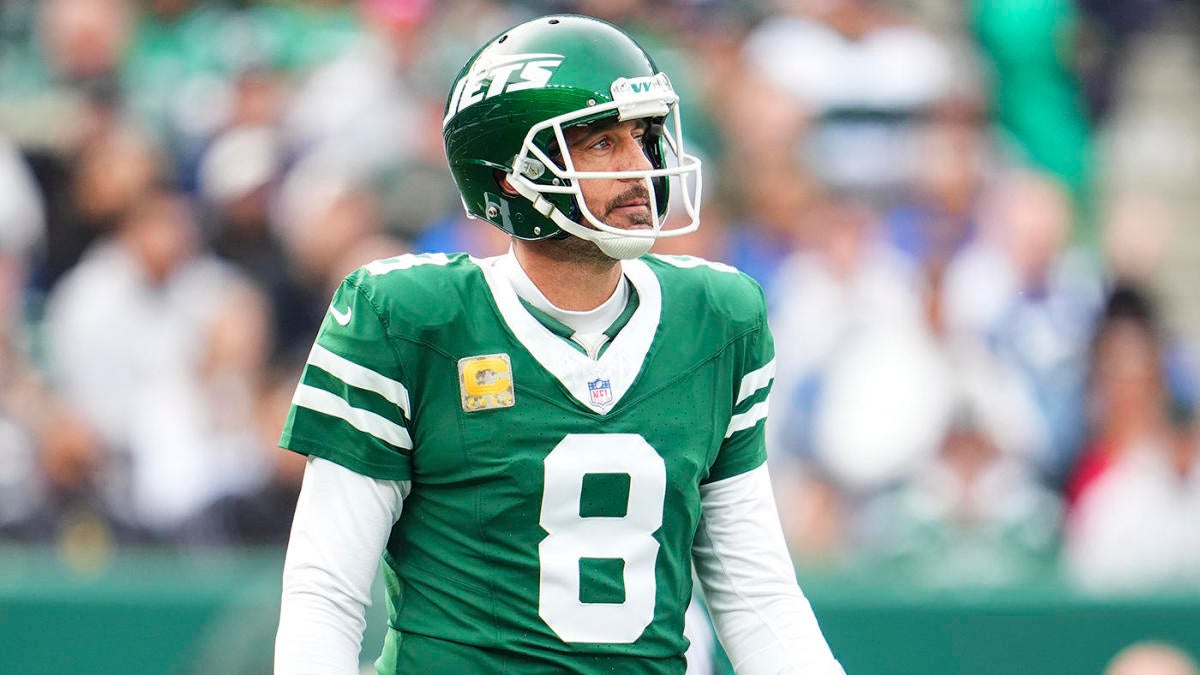Jobs
Fed set to cut interest rates: What it could mean for inflation, economy, jobs

Jerome Powell says Fed rate cut could be on table at next meeting
Federal Reserve Chair Jerome Powell says an interest-rate cut could come as soon as September.
Bloomberg
Now that it’s pretty much a no-brainer that the Federal Reserve will cut interest rates on Sept. 18 — even better odds than the Detroit Lions winning the Super Bowl in 2025 — we move on to the next economic question mark.
Will the Fed’s first rate cut — and subsequent rate cuts ahead — be too little too late when it comes to avoiding a recession in the next year? How much could unemployment go up?
Five days before the next Fed announcement, CME FedWatch, which tracks the probabilities of Federal Reserve actions, put an 53% probability of a quarter-point rate cut on Sept. 18 and a 47% chance was given to an even deeper cut, a half of a percentage point cut, that day.
The probabilities — based on market activity in the involving 30-Day Fed Funds futures contracts — kept growing last week for a deeper cut of a half point, which would drop the short-term federal funds rate to a range of 4.75% to 5%.
Recession fears have heated up as the labor market has cooled down. Cracks have started to show in the foundation of Michigan’s previously vigorous recovery from the COVID-19 pandemic, mirroring a national trend, according to an economic outlook released by University of Michigan economists in September.
Michigan’s jobless rate hit 4.4% in July after sitting at 3.9% from February through May. The University of Michigan Research Seminar in Quantitative Economics is forecasting that Michigan’s unemployment rate will hit 4.7% in 2025 and decrease to 4.5% by the end of 2026.
The economists stated: “We are not hitting the panic button just yet.”
Inflation has “retreated decisively enough for the Fed to deliver significant relief on interest rates soon,” according to the U-M report written by economists Jacob T. Burton, Gabriel M. Ehrlich, and Michael R. McWilliams.
And they said the Fed could “pivot to interest rate cuts in time to prevent a recession.” Slower growth, though, remains in the forecast.
Whether the Fed can engineer a soft landing or slowdown and avoid a recession remains up for debate. Softer job growth has led some — including UBS Wealth Management and J.P. Morgan — to raise the odds of a recession.
The Fed moved the short-term federal funds rate up from nearly 0% in early 2022 to a range of 0.25% to 0.5% after the first rate hike in March 2022. And 10 more rate hikes followed, with the last rate hike hitting in July 2023 and driving up the rate to a range of 5.25% to 5.5%.
Now, the Federal Reserve needs to take its foot off the brakes to stop holding back car sales, home sales and other interest-rate sensitive purchases. Inflation has cooled significantly since from the 9.1% spike in June 2022 — the highest rate since the early 1980s.
The Consumer Price Index for August released Sept. 11 indicated that year-over-year inflation grew at its slowest pace in three years. Year over year, the CPI increased 2.5% in August.
The Consumer Price Index rose 0.2% on a month-to-month seasonally adjusted basis in August, the same increase as in July, according to the U.S. Bureau of Labor Statistics.
The latest data indicates that inflation remains on track to come closer to the Fed’s 2% target in early 2025, according to a report by Diane Swonk, chief economist for KPMG US.
“Prices at the gas pump fell during the month and look poised to fall farther in September, while prices at the grocery store moved sideways,” Swonk noted.
In another report, Swonk said the mood at the Fed has shifted from “needing to stifle inflation to urgency in stimulating growth.”
Inflation was hot but not as bad as decades ago
Many millennials never saw prices soar so fast as they did in recent years at the grocery store, the gas station and elsewhere. But baby boomers can well remember the runaway inflation we saw decades ago.
While prices rose significantly, post-pandemic inflation never came close to the highest levels in U.S. history, as suggested by former President Donald Trump in the presidential debate on Sept. 10.
“They had the highest inflation, perhaps in the history of our country, because I’ve never seen a worse period of time,” Trump stated.
Yet, the annual rate of inflation was 14.4% in 1947, a year after the 78-year-old presidential candidate was born. And most baby boomers can remember that inflation soared to shockingly, unforgettable levels when Trump was in his late 20s and 30s.
An online historical table from the Federal Reserve Bank of Minneapolis goes back to 1913. The yearly figures reflect comparisons of the annual average CPI. The highest annual percent change in the rate of inflation listed on the chart was 17.8% in 1917, which was followed by 17.3% in 1918.
Inflation remained relatively low through most the 1950s and 1960s with some significant exceptions, including when inflation hit 7.9% in 1951 and 5.5% in 1969, according to data from the U.S. Bureau of Labor Statistics.
The 1970s and 1980s were marked by stretches of rampant inflation, which skyrocketed to levels as high and higher than the spike we saw in mid-2022.
Only one year in the 1970s — 1972 — had an annual percent change in the rate of inflation rate that was below 4%. The rate was 3.3% in 1972.
The annual rate of inflation reached 11.1% in 1974 and hit 9.1% in 1975.
President Gerald R. Ford declared inflation as “Public Enemy No. 1” and a “Whip Inflation Now” program was introduced in 1974. But that program didn’t do much, except create memories of red WIN buttons everywhere.
Inflation cooled somewhat after 1975. But inflation rates were still high at 5.7% in 1976, 6.5% in 1977 and 7.6% in 1978.
Then, inflation took off like wildfire — hitting 11.3% in 1979, 13.5% in 1980, and 10.3% in 1981, according data from the U.S. Bureau of Labor Statistics. It went down, if you will, to 6.1% in 1982.
Anyone who was a teenager or older during those high inflation days in the 1970s and 1980s will never, ever forget the stress that middle class families faced as they dealt with soaring prices for gas and groceries, particularly meat. Many also got hit with layoffs and job cuts at the same time, triggering what’s called stagflation.
Many families aren’t likely to easily forget higher prices, even as inflation cools. Inflation will remain a hot button issue during the presidential campaign this fall that GOP candidate Trump knows could hurt Vice President Kamala Harris and the Democrats in 2024.
Overall, prices aren’t returning to levels before the pandemic. But declines in prices in some areas — such as energy prices and used cars — are helping out. And many consumers are still benefiting from wage gains during a tight labor market.
Inflation, while stubborn early on, has come down. Some may still debate how much Fed action helped or whether the inflation we saw in the last few years was relatively temporary anyway, given that inflation was fueled by supply chain disruptions during the pandemic and Russia’s invasion of Ukraine in February 2022.
The annual rate of inflation was 1.2% in 2020 but climbed to 4.7% in 2021 and spiked at 8% in 2022.
Inflation dropped to 4.1% in 2023. An early estimate for 2024 was 3.2%, which is based on the change in the CPI from second quarter 2023 to second quarter 2024.
Even so, a dollar isn’t buying as much overall as it did back in 2020. It would take you $1.21 in 2024 to buy what one dollar would buy you four years ago, according to an online inflation calculator from the Minneapolis Fed.
Run the numbers, again, to show the low inflation years that we saw earlier. It would have cost you $1.08 in 2020 to buy what one dollar would have bought you in 2016.
But if you play around with that calculator, you can see the brutal impact of several years of high, on-going inflation from 1970 to 1982. It would have cost you $2.49 in 1982 to buy what one dollar would have bought you in 1970.
Taking a looking at just one four year period, it would have cost you $1.45 in 1980 to buy what one dollar would have bought you in 1976 — one reason why President Jimmy Carter lost to GOP candidate Ronald Reagan in 1980.
“Inflation has remained significantly higher than the pre-pandemic norm for Michiganders,” according to the University of Michigan economists.
Local inflation, they said, is likely to “remain outside of Michiganders’ comfort zones for some time, even as it continues to cool.”
On an annual basis, Detroit CPI inflation peaked at 8.2% in 2022 and fell to 5.4% last year, largely due to declines in energy prices, the U-M report noted. Inflation has been higher recently in Detroit, according to economists, due to a spike in the shelter component, although they caution that the shelter component’s behavior has been erratic recently.
“Rising local shelter costs are making recent data difficult to interpret.”
The U-M forecast called for annual local inflation to slow to 3.8% in 2024 and 3.2% in 2025, before finally dipping to 2.5% in 2026.
What’s the Fed going to do?
Going forward, consumers are going to get some relief here from high interest rates in the months ahead. And that will lower their costs when they’re borrowing to buy many items.
Bill Adams, chief economist at Comerica Bank in Dallas, is forecasting that the Fed will make three quarter percentage point cuts this year. He’s looking for rate cuts at the September, November, and December meetings in 2024.
If so, the short-term federal funds rate could drop to a range of 4.5% to 4.75% by the end of this year.
Adams expects that the Fed will cut rates five more times in 2025. He’s forecasting quarter percentage point cuts in January, March, June, September, and December. If so, that would bring the short-term rate down to a range of 3.25% to 3.5% by the end of 2025.
“The economy will likely avoid a recession over the next year,” Adams told the Detroit Free Press. “I put the odds of a recession over the next twelve months at one in three, and over the next six months at one in five.”
More: What one woman did when high credit card rates nearing 30% triggered high anxiety
More: Fed is set to cut rates soon: Here’s what it could mean for car loans
Mark Zandi, chief economist at Moody’s, said he expects the Fed to cut rates by one quarter percentage point in September, and then another quarter point cut in December.
He expects another four rate cuts through the end of 2025, each a quarter percentage point, putting the federal funds rate just below 4%.
“The odds are good, about 80%, the U.S. economy will avoid a recession through the end of 2025,” Zandi said, “particularly as the Fed lowers interest rates and take pressure off the financial system and job market.”
Zandi points to the firepower that remains in American wallets.
“American consumers continue to drive the economic train,” Zandi said, “as they are benefitting from resilient job growth, low unemployment, solid real wage gains, and record high stock and house prices.”
Many are struggling to pay bills. But economists note that high income households still have plenty of cash sitting in their checking accounts, built up during the pandemic when they were unable to spend.
High interest rates for car loans, mortgages, credit cards and other loans are holding back the consumer’s ability to buy appliances, cars, homes and other goods overall. But spending in those areas could go up, Zandi said, as rates go down.
“They are like a coiled spring,” Zandi said. “As the Fed cuts interest rates, activity in them should bounce back, stabilizing economic growth and job creation, and lengthening the economic expansion.”
Zandi predicted that the economy will get a lift as the Fed lowers interest rates.
Households with credit card and consumer finance debt, Zandi said, should gradually see their interest payments begin to decline.
Over time, analysts expect that interest rates on auto loans and mortgages should moderate further, helping with affordability and demand. Make no mistake, though, the Fed’s impact on credit card rates and car loans will likely be gradual.
Other threats to economic growth, of course, can remain unknown at this point.
Zandi noted that a close and contentious presidential election could pose a threat to the economy, particularly if it takes a long time to resolve and is the catalyst for social unrest.
“Post election, lawmakers will need to increase the Treasury debt limit and decide what to do with the tax cuts that are set to expire for individuals at the end of the 2025. This could be difficult to do politically and undermine confidence and the economy,” he said.
Contact personal finance columnist Susan Tompor: stompor@freepress.com. Follow her on X (Twitter) @tompor.








